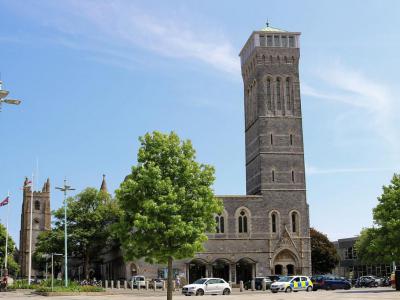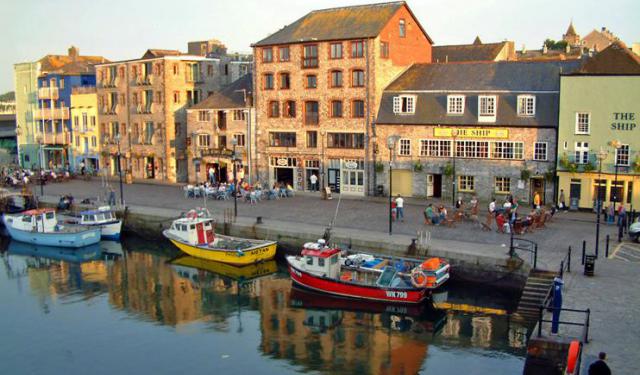Guildhall, Plymouth
Historically, Plymouth has had five guild halls. The first guilt hall, dated back to the 15th century, was located in the Old Town section of Plymouth. It was replaced by the second hall erected in the Southside Street / Wooster Street area in 1440. In 1607, a third hall, a Jacobean structure, was built on High Street. It was demolished in 1800 and replaced by the fourth guilt hall, designed by John Eveleigh, a surveyor, and architect from Bath. The fifth and current Guildhall foundation stone was laid in July 1870. This one proved to be a keeper.
Guildhall was created by Edward William Godwin, a progressive designer and architect. Godwin's Gothic Revival hall was opened by Edward, Prince of Wales, in August 1874. The Guildhall block was 292 feet long and included the Assize Courts.
On the south corner of the building, the great tower commanded the block, rising to 190 feet. Over the center of the Guildhall was a spire with a finial 140 feet above the ground. Internally, the main room, the Great Hall, features a nave of 58 feet wide and 70 feet high. Granite pillars separated it from the aisles. The hall was designed to hold up to 2,600 people.
In 1941, the Guildhall and surrounding buildings were damaged during the Plymouth Blitz, a series of bombing raids of the Second World War. The restoration work started in 1954 and finished in 1959. The hall was rebuilt according to the plans of City Architect Hector J. W. Stirling.
The interior of the building features a wide marble staircase that leads to the Great Hall. The mahogany-paneled upper hall measures 106 feet by 57 feet. The lower entry is underneath. Three chandeliers in the Great Hall represent the old "Three Towns" (Plymouth, Stonehouse, and Devonport). The vast Gobelin Tapestry of Raphael's "Miracle of the Fishes" is a gift from Napoleon III.
The Grade II listed building, today Guildhall acts as a venue for a wide variety of events throughout the year, including graduations, awards, weddings, and concerts.
Guildhall was created by Edward William Godwin, a progressive designer and architect. Godwin's Gothic Revival hall was opened by Edward, Prince of Wales, in August 1874. The Guildhall block was 292 feet long and included the Assize Courts.
On the south corner of the building, the great tower commanded the block, rising to 190 feet. Over the center of the Guildhall was a spire with a finial 140 feet above the ground. Internally, the main room, the Great Hall, features a nave of 58 feet wide and 70 feet high. Granite pillars separated it from the aisles. The hall was designed to hold up to 2,600 people.
In 1941, the Guildhall and surrounding buildings were damaged during the Plymouth Blitz, a series of bombing raids of the Second World War. The restoration work started in 1954 and finished in 1959. The hall was rebuilt according to the plans of City Architect Hector J. W. Stirling.
The interior of the building features a wide marble staircase that leads to the Great Hall. The mahogany-paneled upper hall measures 106 feet by 57 feet. The lower entry is underneath. Three chandeliers in the Great Hall represent the old "Three Towns" (Plymouth, Stonehouse, and Devonport). The vast Gobelin Tapestry of Raphael's "Miracle of the Fishes" is a gift from Napoleon III.
The Grade II listed building, today Guildhall acts as a venue for a wide variety of events throughout the year, including graduations, awards, weddings, and concerts.
Want to visit this sight? Check out these Self-Guided Walking Tours in Plymouth. Alternatively, you can download the mobile app "GPSmyCity: Walks in 1K+ Cities" from Apple App Store or Google Play Store. The app turns your mobile device to a personal tour guide and it works offline, so no data plan is needed when traveling abroad.
Guildhall on Map
Sight Name: Guildhall
Sight Location: Plymouth, England (See walking tours in Plymouth)
Sight Type: Attraction/Landmark
Guide(s) Containing This Sight:
Sight Location: Plymouth, England (See walking tours in Plymouth)
Sight Type: Attraction/Landmark
Guide(s) Containing This Sight:
Walking Tours in Plymouth, England
Create Your Own Walk in Plymouth
Creating your own self-guided walk in Plymouth is easy and fun. Choose the city attractions that you want to see and a walk route map will be created just for you. You can even set your hotel as the start point of the walk.
Pilgrim Fathers Trail
Back in the early 17th century, a group of English Puritans – nowadays reverently referred to as the Pilgrim Fathers – fled religious persecution in their homeland and established a colony in North America that later became known as Plymouth, Massachusetts. The Pilgrims embarked on their perilous journey across the Atlantic from Plymouth, England in 1620 aboard a ship called the Mayflower,... view more
Tour Duration: 1 Hour(s)
Travel Distance: 0.5 Km or 0.3 Miles
Tour Duration: 1 Hour(s)
Travel Distance: 0.5 Km or 0.3 Miles
Plymouth Hoe Walking Tour
Plymouth Hoe, referred to locally as the Hoe, is a large south-facing open public space in Plymouth with commanding views of Plymouth Sound, Drake's Island, and further afield into Cornwall. The name derives from the Anglo-Saxon word hoh, which means a sloping ridge shaped like an inverted foot and heel.
This part of town has always been a meeting place, where people would come regularly... view more
Tour Duration: 1 Hour(s)
Travel Distance: 0.7 Km or 0.4 Miles
This part of town has always been a meeting place, where people would come regularly... view more
Tour Duration: 1 Hour(s)
Travel Distance: 0.7 Km or 0.4 Miles
Plymouth Introduction Walking Tour
Plymouth's early history began in the Bronze Age when the first settlement emerged at Mount Batten. It is mentioned in Ptolemy's Geographia as a maritime outpost exporting bronze mirrors.
The settlement was a major port in the southwest of England in Roman times. It was surpassed as a port in the ninth century by the nearby wealthier village of Sutton, later called Plymouth.
... view more
Tour Duration: 1 Hour(s)
Travel Distance: 1.9 Km or 1.2 Miles
The settlement was a major port in the southwest of England in Roman times. It was surpassed as a port in the ninth century by the nearby wealthier village of Sutton, later called Plymouth.
... view more
Tour Duration: 1 Hour(s)
Travel Distance: 1.9 Km or 1.2 Miles






